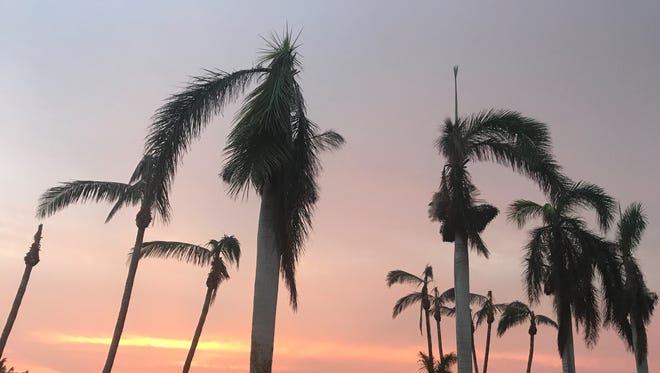Gardening: Selecting, trimming trees for hurricane season

With hurricane season upon us, and an above average number of storms predicted, you should know how to minimize wind damage in your landscape.
Trees and shrubs can grow too large or unbalanced to be able to withstand wind storms, so it is wise to learn how to prune and shape trees to minimize damage.
Avoiding storm damage begins with the initial selection of your plants. You should take into consideration the branch and trunk strength of the trees being considered for planting, how strong their root system is, and their placement near structures and utilities.
More:Gardening: Add some perennials in with your summer annuals
Trees planted in wet areas or close to sidewalks and driveways can have stunted root systems allowing them to blow over easily. A regular system of pruning should then be established. Pruning should develop a sturdy well-spaced framework of healthy branches with an open canopy that allows air to move freely.

A study by University of Florida Professor Ed Gilman suggests reducing the size of the canopy by trimming the long side branches. When trees are thinned, by removing the branches from the middle, the outer limbs grow too long, and the weight is no longer distributed properly. These trees become top heavy and topple in the hurricane winds.
There are some tree species that stand up to strong winds much better than others. Although no tree can be guaranteed to stand up to hurricane force winds, the following trees are more likely to withstand strong winds: Geiger tree, mango, sapodilla, live oak, mahogany, tamarind and palms which tend to flex with the wind rather than snap.
There are also trees noted for dropping branches or splitting apart under stress. Losing leaves and twigs in a high wind will make a mess in the garden but may give the trees an advantage by reducing the stress on the main branches. The following trees are likely to lose major branches: gumbo limbo, eucalyptus, tabebuia, and avocado.
Most species fall between the extremes and have a good chance of surviving a moderate to strong storm intact provided they have had a proper pruning.
The most wind resistant form for a tree is one with a central leader and a well-spaced framework of branches around and up and down the trunk. Most trees can be grown in this form when they are young, but the growth habit of some species will change to a multi-trunk spreading form as they mature. There should be no narrow forks or branches leaving the trunk at an acute angle since these branches are likely to split under stress. Crotches from 45 to 90 degrees are less likely to split than narrow V crotches of less than 40 degrees.
Young trees should not be cut back to make them bushy but should rather be encouraged to form a strong leader with well-spaced branches out to the side that are held back enough to stop them from forming multiple, competing leaders. A young tree can have the lower branches removed over a period to give a clear trunk to whatever height is desirable. It should not be cleaned of laterals in the lower part of the trunk too soon, since the branches there will help give a larger trunk diameter and a much sturdier tree. Later pruning should consist of forming a well-spaced framework of strong branches and a pleasing outline to the tree. Remember not to let those branches become too long lest you have a top heavy tree.
Faced with a storm, gardeners who have kept their trees thinned and with a canopy in proportion to the trunk have little to do. For a neglected tree severe surgery may be necessary. Begin by cutting out "sucker shoots" and cut out crossing branches or those growing into the center of the tree. Select a well space framework of branches and cut the others out completely, finally trim branches to give the tree a balanced top.
As for palms, a practice called “hurricane cutting” is not a good idea. This practice involves removing not only the dead, brown fronds but also beneficial green fronds, leaving only a few fronds sticking straight into the air like a telephone pole. Severe cutting of the fronds will stunt root growth, which in turn will stunt the tree’s growth and leave it susceptible to diseases and without a good root system to help it survive hurricane winds. This practice also weakens the area surrounding the heart of the tree making it more likely that the entire top of the palm will be torn off in high winds. Removing green fronds also reduces leaf surface area which decreases the tree’s ability to harvest sunlight for more food. Palms also take moisture from the air through their fronds. Obviously, hurricane cutting of your palms only weakens them making them more susceptible to hurricane damage. Remember the rule, if the frond is green and not interfering with anything leave it because the tree is using it.
It is probably inevitable that someday we will suffer another Hurricane Donna, Andrew, Wilma or Irma. Prepare your landscapes by properly pruning your trees and plants and you’ll increase the odds of keeping all of them intact.
More:Gardening: The fertilizer deadline nears
Eileen and Peter Ward have owned a landscape and lawn maintenance company for 35 years. Eileen can be reached at Gswdmarco@comcast.net or 239-394-1413.